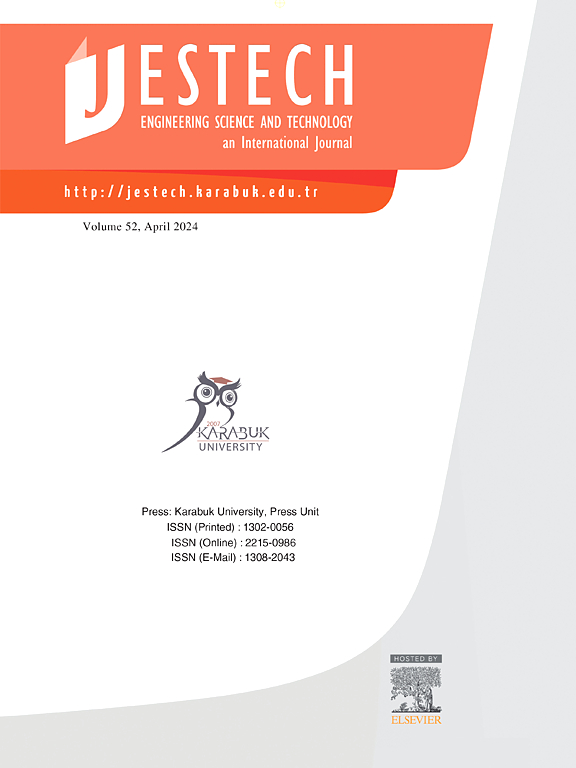Investigating crumb rubber-modified geopolymer composites derived from steel slag for enhanced thermal performance
IF 5.1
2区 工程技术
Q1 ENGINEERING, MULTIDISCIPLINARY
Engineering Science and Technology-An International Journal-Jestech
Pub Date : 2024-11-01
DOI:10.1016/j.jestch.2024.101880
引用次数: 0
Abstract
Thermal performance of building materials is often improved by introducing air voids through foaming. However, this typically results in a reduction in compressive strength. To address this issue, an experimental study was conducted to develop thermally efficient geopolymer blocks using three grades of crumb rubber (CR), without compromising compressive strength. Tests such as compressive strength, tensile strength, thermal conductivity, water absorption, and porosity were carried out to assess the performance of these blocks in comparison to conventional geopolymer blocks. The CR-incorporated geopolymer blocks demonstrated low thermal conductivity, ranging from 0.63 to 0.43 W/mK, along with a reduced environmental impact and carbon footprint. Importantly, they exhibited high compressive strength, ranging from 25 to 52 MPa, which exceeds the required strength for first-class bricks (12 MPa). A computational conjugate heat transfer analysis was also carried out to evaluate the strength of heat transferred through the solid media to the internal fluid media. It contributes to the advancement of environmentally conscious building materials, emphasizing the potential benefits of crumb rubber-incorporated geopolymer composites as a novel material for building construction purpose.
研究从钢渣中提取的碎屑橡胶改性土工聚合物复合材料,以提高热性能
建筑材料的热性能通常是通过发泡引入空气空隙来改善的。然而,这通常会导致抗压强度降低。为解决这一问题,我们开展了一项实验研究,在不影响抗压强度的前提下,使用三种等级的碎屑橡胶(CR)开发热效率高的土工聚合物砌块。通过抗压强度、拉伸强度、导热性、吸水性和孔隙率等测试,评估了这些砌块与传统土工聚合物砌块的性能对比。加入 CR 的土工聚合物砌块的导热系数较低,在 0.63 到 0.43 W/mK 之间,同时还减少了对环境的影响和碳足迹。重要的是,它们具有很高的抗压强度,从 25 兆帕到 52 兆帕不等,超过了一级砖所要求的强度(12 兆帕)。此外,还进行了计算共轭传热分析,以评估通过固体介质向内部流体介质传递热量的强度。该研究为环保型建筑材料的发展做出了贡献,强调了屑橡胶融入土工聚合物复合材料作为新型建筑材料的潜在优势。
本文章由计算机程序翻译,如有差异,请以英文原文为准。
求助全文
约1分钟内获得全文
求助全文
来源期刊

Engineering Science and Technology-An International Journal-Jestech
Materials Science-Electronic, Optical and Magnetic Materials
CiteScore
11.20
自引率
3.50%
发文量
153
审稿时长
22 days
期刊介绍:
Engineering Science and Technology, an International Journal (JESTECH) (formerly Technology), a peer-reviewed quarterly engineering journal, publishes both theoretical and experimental high quality papers of permanent interest, not previously published in journals, in the field of engineering and applied science which aims to promote the theory and practice of technology and engineering. In addition to peer-reviewed original research papers, the Editorial Board welcomes original research reports, state-of-the-art reviews and communications in the broadly defined field of engineering science and technology.
The scope of JESTECH includes a wide spectrum of subjects including:
-Electrical/Electronics and Computer Engineering (Biomedical Engineering and Instrumentation; Coding, Cryptography, and Information Protection; Communications, Networks, Mobile Computing and Distributed Systems; Compilers and Operating Systems; Computer Architecture, Parallel Processing, and Dependability; Computer Vision and Robotics; Control Theory; Electromagnetic Waves, Microwave Techniques and Antennas; Embedded Systems; Integrated Circuits, VLSI Design, Testing, and CAD; Microelectromechanical Systems; Microelectronics, and Electronic Devices and Circuits; Power, Energy and Energy Conversion Systems; Signal, Image, and Speech Processing)
-Mechanical and Civil Engineering (Automotive Technologies; Biomechanics; Construction Materials; Design and Manufacturing; Dynamics and Control; Energy Generation, Utilization, Conversion, and Storage; Fluid Mechanics and Hydraulics; Heat and Mass Transfer; Micro-Nano Sciences; Renewable and Sustainable Energy Technologies; Robotics and Mechatronics; Solid Mechanics and Structure; Thermal Sciences)
-Metallurgical and Materials Engineering (Advanced Materials Science; Biomaterials; Ceramic and Inorgnanic Materials; Electronic-Magnetic Materials; Energy and Environment; Materials Characterizastion; Metallurgy; Polymers and Nanocomposites)
 求助内容:
求助内容: 应助结果提醒方式:
应助结果提醒方式:


